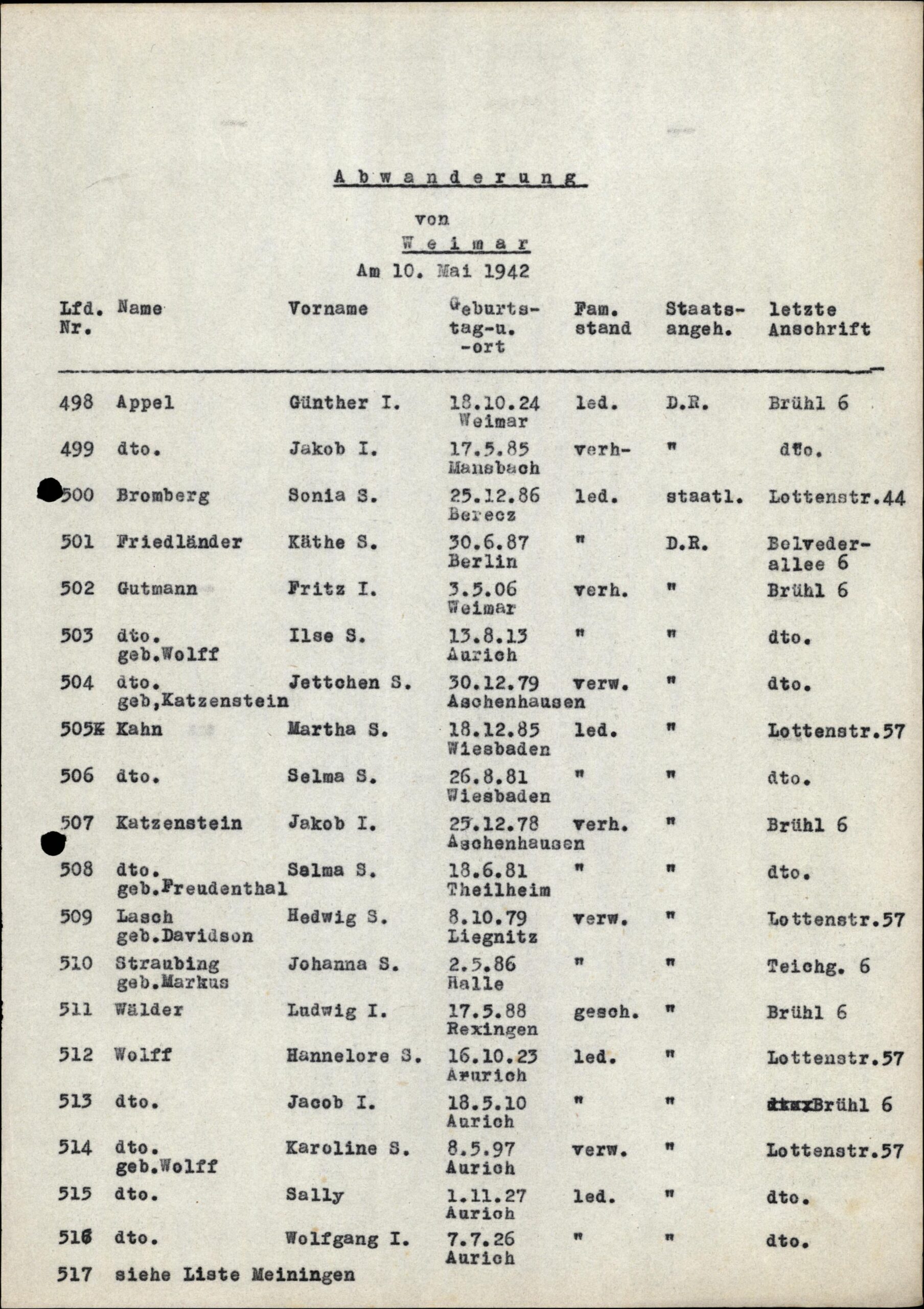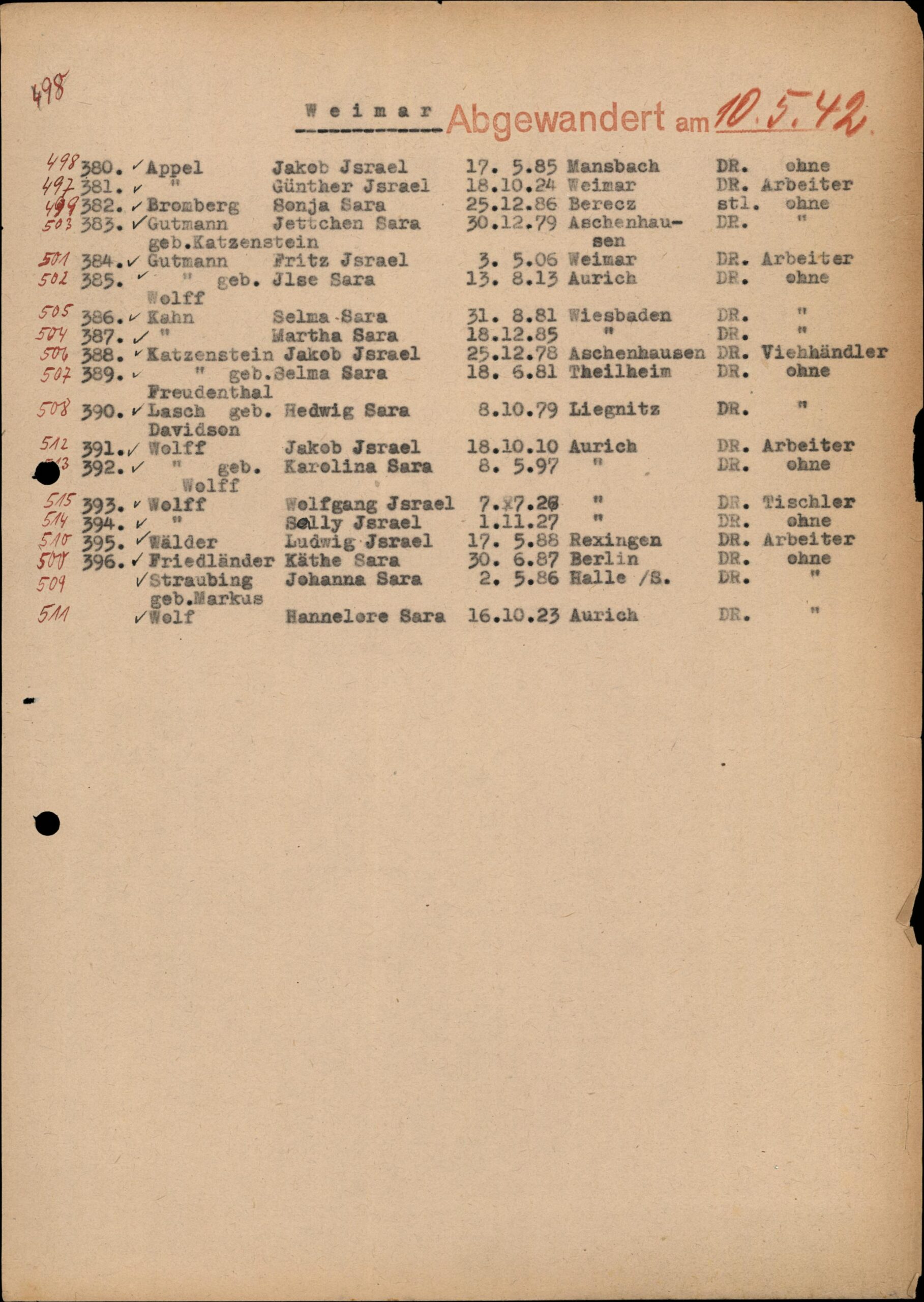What We Know:
Family name: Wolff
Given name: Selly
Date/place of birth: 1. November 1927, Aurich
Date/place of death: Exact date of death unknown
Age: 15 years old at deportation
![]()
Selly Wolff was born 1 November 1927 in Aurich, Germany. His parents were Martin Wolff (24.09.1894) and Karoline Wolff geb. Wolff (08.05.1897). Selly was the youngest of five children. He had three sisters, Rösel (02.06.1921), Hildegard (08.08.1922) and Hannelore (16.10.1923), and a brother, Wolfgang (07.07.1926). The family lived together at Leerer Landstraße 18 in Aurich.
Selly’s father Martin worked as a butcher and cattle dealer in the town of Aurich under his own father, Wolff Abraham Wolff (1858-1926). The Wolff family ties run deep in the town of Aurich dating back to the 1690’s, nine generations before Selly was born. After Wolff’s death in 1926, Martin continued to run the family business with the help of his own growing family. Martin’s mother was Rosetta Wolff, geb. Schönthal. He had a twin brother named Abraham and a sister, Hannah.
Selly’s mother, Karoline Wolff, was the second eldest of eleven children from parents Selly Wolff (13.03.1863- 23.08.1930) and Henriette Wolff geb. Von der Walde (24.07.1874). Her father was also very well known in the cattle business in Aurich, perhaps connecting the two families through business prior to Karoline and Martin’s marriage.

***
In 1934, Martin, Karoline and their five children moved to Sandhorst, a small village in Aurich, where they stayed at the Eschen estate. Here the family was welcomed by the owner Menko Dieken who often rented to Jewish cattle dealers in the area. In the following years the Wolff family organized holiday stays for Jewish children from Bremen and Berlin who were not included in the protective measures of “Kinderlandverschickung”, a strategy put in place to shelter German children from the risks of air raids. Information regarding the Wolff family’s efforts to help protect Jewish children did not go unnoticed by the Nazis of Aurich and soon the family was forced to leave the estate in Sandhorst, moving back to Aurich in September of 1938 where lived at Marktsraße 4.

On 10 October 1939, Selly, his brother Wolfgang, and his parents were officially registered as Jewish residents of Aurich. Kristallnacht, although not directly resulting in arrests or attacks on the Wolff family, created an urgency in the family to take action. Karoline and Martin organized plans to keep their children safe. 1939-1940 the Wolff family was separated from one another, Rösel emigrated to England in 1939 and Hildegard to Palestine in 1940. Hannelore went to Berlin where she attended a school for Jewish kindergarten teachers, and the two young boys, Wolfgang and Selly were sent to Cologne to a Jewish children’s home.
In 1940, Karoline and Martin were forced to leave Aurich and moved to Weimar with Karoline’s mother Henrietta.
15 January 1942, Martin Wolff was arrested for riding his bike home without permission while he was carrying out his assigned job delivering potatoes, a crime at the time as a Jew. Due to his contributions as a soldier in World War I and an injury to his leg where he was shot, Martin Wolff had felt a sense of security that him and his family would be safe, however his lack of mobility made him a target as someone who was unable to work. Initially he was imprisoned in Buchenwald concentration camp 23 January 1942, and was later transferred and murdered 12 March 1942 in Bernburg killing centre. His family received a note and his ashes from Buchenwald stating his date of death.


***
Selly, Wolfgang, and Karoline learned they would be deported on 10 May 1942. From Berlin with news of her family’s deportation, Hannelore wrote to the Gestapo asking to be added to the transportation list from Weimar to Belzyce Ghetto. The family was living with Karoline’s mother at the time, Henriette. Too old for the Belzyce deporatation Henriette said goodbye to her daughter and grandchildren. Henriette was deported to Theresienstadt Ghetto 19 September 1942 and was murdered 10 March 1944.
On 10 May 1942, Wolfgang, Selly, Hannelore, and their mother Karoline were deported, arriving in Lublin Ghetto on 12 May 1942.


Selly, Wolfgang, Hannelore and their mother Karoline lived together in the Lublin Ghetto, sharing a small room with another family. Wolfgang and Selly were forced to work in the nearby quarry. Hannelore worked for the family of the Untersturmführer, the Lichter family, taking care of their two young children. Karoline worked in a lamp factory. In the ghetto Hannelore remembers being shocked by the presence of a post station and decided to send a letter to her father’s sister, Hannah, and her husband, Karl Friedenberg who had fled to Holland. She eventually received a reply and a small package containing rice and beans. Hannah and Karl both survived the Holocaust.
As described in Hannelore’s memoir, one night in their ghetto flat, Wolfgang was woken up and taken off to a supposed work assignment in the middle of the night and never returned. Hannelore discovered the next day that he had been taken to Majdanek concentration camp. Like many victims of the Holocaust, Wolfgang’s fate and exact date of death is unknown. He was 16 years old when he was taken that night.
After being warned by a Judenrat member that the Lublin Ghetto was being liquidated in October 1942, Selly, Hannelore and Karoline went into separate hiding to avoid deportation. After a short while, Hannelore was caught and sent to Belzyce Ghetto. Selly lost contact with his mother and sister during the liquidation and only reconnected with Hannelore when he arrived at the Belzyce Ghetto ‘hospital’ after being severely attacked by a Kapo. Hannelore worked in the infirmary there and did all she could to help her brother under the conditions of the ghetto. They never saw their mother after separating in the Lublin Ghetto, the date of her death is unknown, and whether or not she made it from Lublin to Belzyce is also unknown.
While working in the infirmary in Belzyce, Hannelore was selected to be transferred to Kraśnik, a sub camp of Majdanek. She worked an administrative job and was brutally assaulted by one of the captains of the camp who had promised to help free her. She was then transferred on her own to Budzyn, where she reconnected with her brother Selly and where she first met Bernhard (Dick) Hillman, a Polish Jewish prisoner of war.
Selly suffered from a collapsed lung after being attacked by a kapo in Belzyce Ghetto. The extremely poor conditions of the ghetto and camp, including but not limited to the brutal work and living conditions, as well as the meager food rations, made his efforts of healing very hard. After being selected as a “musselmann” (camp lingo for those who were barely alive), Selly was sent to the forest, where it was known in the camp that prisoners were shot into mass graves. As Hannelore recounts in her memoir, in hearing of her brother’s selection, she approached an officer claiming her brother’s selection should be revoked as he was capable of working, knowing this wasn’t true. Selly was brought back from the forest, and despite his declining health and inability to contribute to the camp labour, was sent to the infirmary. Selly died shortly after in the camp infirmary. He was 15 years old.
***
Over three years Hannelore was transferred through six ghettos and concentration camps. In 1944, Hannelore and the “Schindler women” in Auschwitz-Birkenau were collected and brought to Brünnlitz camp where Schindler’s factories were located. On 8 May 1945 Brünnlitz was liberated. Hannelore and Dick were married on 22 October 1945. The couple spent almost two years as displaced persons in Germany before they emigrated to the United States, arriving in New York on 4 January 1947. Upon their arrival in the USA Hannelore became Laura Hillman. Dick and Laura had one son named Robert in 1954. Dick Hillman died in 1986. Laura Hillman was invited along with her sister Rösel to visit Aurich on a few occasions but refused. Instead, she chose to visit East Frisia in 2004 with her 16 year old grandson Ayeh, where she was able to visit as a private person and show him where she had grown up, along with the cemetery where her grandparents lie, and the memorial where the 310 Jewish victims of the Holocaust from Aurich are commemorated. [1] She published her memoir “i will plant you a lilac tree: a memoir of a Schindler’s list survivor” in 2005 where she shares details about her family’s fate as it intertwines with her own story of survival. Hannelore/Laura Hillman, geb. Wolff, died 4 June 2020 at the age of 96.
Hildegard emigrated to Palestine through Yugoslavia in 1940, and was kept by the British authorities as an illegal immigrant for some time. She was released and married a German Jewish man from Frankfurt, Max Frenkel (1913-1983). Hildegard and Max had three boys, one named Moshe after his grandfather Martin, and they settled with their family in Jerusalem. On July 11th 1978 Hildegard died of Leukemia at the age of 56.
Rösel initially emigrated to England in 1939 with the help of her parents. She was trained as a nurse and married Arthur Goldstein with whom she had two daughters, Carolyn and Sharon. She moved to Dublin Ireland in the early 1970’s after the death of her first husband, where she met and married her second husband Asher Siev. In 1992 Rösel was invited by the mayor of Aurich to visit the city for a week of encounters with other former Jewish citizens, to which she refused due to the memories and loss of 63 family members to the hands of the Nazi’s. Rösel died in April of 2019 in Manchester, England at the age of 97. She had 15 grandchildren and 35 great-grandchildren.
Out of Karoline’s eleven siblings, only three survived the Holocaust. Stolperstein have been laid for her mother and some of her siblings at Lilienstraße 9 in Aurich.
Stolperstein have been laid for Selly, his siblings and his parents at Leerer Landstraße 18 in Aurich.

Sources:
Laura Hillman, „I Will Plant You a Lilac Tree: A Memoir of a Schindler’s List Survivor“ (2006)
[1] https://stolperstein-geschichten.de/geschichten/laura-hillman/